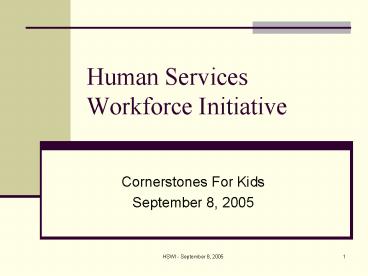Human Services Workforce Initiative - PowerPoint PPT Presentation
1 / 21
Title:
Human Services Workforce Initiative
Description:
We cannot succeed at producing better outcomes for children without addressing the workforce. ... low income children and their families. HSWI - September 8, 2005. 5 ... – PowerPoint PPT presentation
Number of Views:25
Avg rating:3.0/5.0
Title: Human Services Workforce Initiative
1
Human Services Workforce Initiative
- Cornerstones For Kids
- September 8, 2005
2
- At the end of the day, well written policies,
creative program designs and powerful research
findings will add up to very little if the people
actually working with children and families the
frontline child welfare workers, juvenile justice
staff, child care teachers, youth workers,
employment service workers and others are
inexperienced, poorly prepared, overworked, or
discouraged.
3
Underlying Beliefs
- Human services matter.
- Delivered well, they can (and do) make a positive
difference in the lives of children and families.
- There is a relationship between the quality of
staff and the effectiveness of human services
yet workforce issues receive scant attention. - We cannot succeed at producing better outcomes
for children without addressing the workforce. - Improvements can and should be made, at both
practice and policy levels.
4
What is the human services workforce?
- For HSWI, it is the front line staff in 5
fields - - Child welfare
- Juvenile justice
- Child care
- Youth development
- Employment services
- Each has the potential to change the lives of
- low income children and their families.
5
What do we mean by a quality workforce
- A quality workforce is stable, motivated,
- well prepared, subject to realistic
- expectations and well supported by
- supervisors and the organization.
6
A threatened workforce
- A workforce in crisis is characterized by
excessive turnover, inadequate pre-professional
and/or in-service training, burn-out, unrealistic
expectations and antagonistic relationships
between line staff and administration.
7
The challenge
- How can the human services recruit,
- develop and retain a quality workforce?
- How can system reform efforts assure
- that front line staff have the knowledge, skills
- and attitudes necessary to successfully work in
- new ways?
- What contribution can HSWI make?
8
- Studies show that young people entering
- the human services do so because they want
- to help they want to make a difference.
- But before we can expect large numbers of them
- to commit to a job, or an agency, or a field, or
a - career, some things have to be in place
9
- Compensation commensurate with education and
importance. - Benefits to support the worker and family.
- Satisfactory working conditions reasonable,
regular hours freedom from undue stress safety
clear expectations organizational backing and
support good supervision. - Its not just training.
10
The key to improving the quality of the
workforce is improving the quality of the jobs.
11
HSWI Strategies
- HSWI is operating on three overlapping
- strategic paths
- Data spurring greater awareness providing
better information - Best practices disseminating information on
what works - Policy - getting to the underlying systemic
barriers to a quality workforce
12
The Matrix
13
- Each field is in a different stage in terms of
understanding the condition of the workforce, - the visibility of the issues, and consensus on
strategies to improve those condition. - While there are commonalities, solutions will
most likely to be found field by field each is
governed by separate laws and regulations, funded
separately and administered by a different
complex of organizations.
14
Questions of focus What to leave in, what to
leave out
- Gender
- Public attitudes
- Race
- Universities
- Nonprofit issues
- Unions
- Lessons from other fields
- Lessons from other countries
15
Turnover is a critical indicator
- We see turnover as a (the?) primary indicator of
workforce problems - Turnover in human services is like the drop-out
rate in education the one indicator youd look
at if you could only look at one - It is poorly understood rarely measured often
not disaggregated - We want lowered turnover to be seen as an
important, achievable an agency aspiration
16
Some context and thoughts
- The entire American workforce is more mobile than
it used to be what are realistic turnover
expectations today? - People move within a field, naturally.
- Not all turnover is negative.
- Should we learn how to provide services that are
not quite so dependent on the stand-alone skills
of individuals greater use of protocols
decision tools quality assurance supervision?
17
Why turnover is important
- Loss of experience gained
- Need to train and re-train
- Discontinuity of services
- Costs
- Turnover begets turnover caseload size while
recruiting, disruption of services, broken
relationships
18
A Plan for 2005-07
- Initial 3 year plan
- Prepared to be flexible and to hone in on
opportunities and challenges - Participatory, working in partnership
19
2005
- Transition to C4K.
- Stress problem awareness, emerging best practices
web, papers, and presentations. - Form alliances and partnerships, identify
additional funders. - Preliminary scan of policy options.
20
2006
- Dissemination at height.
- Major presentations and publications.
- Expanded allies group and funding base.
- Policy options identified and plans developed.
21
2007 and beyond
- Continued dissemination and coalition
- building.
- Policy focus now paramount.































